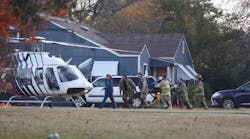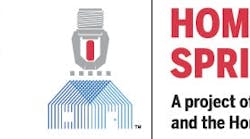FIREHOUSE: What motivated you to move into a role within the Department of Homeland Security’s Science and Technology (S&T) Directorate?
GRIFFIN: Before joining S&T, I spent 20 years working at the local level, serving as a fire chief, emergency manager, town manager and in various other capacities. While the single most important element of having a first-rate emergency response organization is the men and women on the street, I have come to appreciate the critical role technology and science can bring to operations. As first responders face increasingly more complex risks and threats, and budgets continue to decline, technology becomes a key enabler in improving responder safety and increasing operational efficiency.
This was really driven home to me on 9/11. As calls came in, Loudoun County, VA, where I was the chief of fire and rescue, dispatched units all over Northern Virginia, including directly to the Pentagon. At that time, we did not have GPS or GIS in our units and we literally had units stopping at convenience stores to purchase map books. In addition, every major after-action report for the past 25 years has identified the lack of technological interoperability – both for communications and personal protection – as enduring capability gaps.
In order to help close these gaps, I knew that the federal government – particularly DHS – had a role to play helping to develop and field solutions, link first responders with industry and in overcoming the numerous obstacles to developing and fielding new technologies. While I wasn’t looking for a position with the federal government when I was initially contacted about becoming the director of S&T’s newly formed First Responders Group, I realized I could bring a my experience and first responder advocacy to DHS.
FIREHOUSE: What have been the most rewarding and the most challenging aspects of your role at DHS?
GRIFFIN: Challenges first. DHS is still a relatively new organization, a conglomerate of more than 22 pre-existing organizations with pre-existing cultures. Add to the mix newly formed organizations, such as S&T, that had to hit the ground running. DHS is only 11 years old and while at times it acts its age, it continues to grow, evolve and improve.
Another challenge was that the formation of DHS was heavily oriented towards combating terrorism. While that needs to continue to be a key focus, we face manmade and natural hazards every day that are not terrorism related – especially at the local and state levels. As I like to say, all incidents start and end at the local level, so that’s where we need to begin our work. This not only requires a shift in orientation, but also a renewed and constant emphasis on the role of the state and local responders.
There have been numerous rewards, but I want to highlight two. First, and I know this is somewhat of cliche, but since coming to DHS, I have been able to work with some amazing people, both within and outside the department at all levels of government and internationally. They are truly dedicated to the mission of keeping communities and people safe and they are driven to come up with innovative solutions to changing threats.
The second reward for working at DHS is the ability to get involved and help shape technology and related solutions that can truly help. I’ve been able to address those areas of primary concern that drew me to S&T in the first place – communications and data interoperability and improved first responder safety and effectiveness. These are complex issues and there is no magic-bullet solution, especially since technology alone is not the solution. It is only part of the answer and must be balanced with governance, policy, operating procedures and above all everyday use.
We’re doing some exciting things here and have made some advances, and there’s a lot more to come especially as we think about the convergence of communications, data, sensors and wearable technologies.
FIREHOUSE: What motivated you to develop a vision for the “Responder of the Future?”
GRIFFIN: We are living in an incredible time of innovation. Advances in manufacturing, nanotechnology, sensors, smart chips, intelligent fabrics and the “Internet of Things” are enabling individuals to have advanced capabilities in nearly every endeavor, from real-time monitoring for fitness and health to learning, gaming, security, tracking and pretty much anything else you can imagine. Responders need these capabilities every day.
Responders are not like other people. Who else would be crazy enough to run into a burning building and consider it to be just “a day at the office”? Who else would face down terrorists, deal with explosive threats, jump into raging waters and stand against hurricanes to protect citizens? Not to mention just the everyday risks we deal with when we are apprehending a suspect, or rushing across town to get to the scene of a medical emergency.
With these responsibilities comes the critical need to get information at the speed of thought – and in a way that doesn’t interfere with other functions. When a firefighter runs into a burning building, we need real and meaningful information to guide us. But we can’t be burdened with looking up data on a mobile device. We can’t even roll up our sleeves to look at a watch. We need the information right in front of us, and it needs to be intuitive and reliable.
Being a responder, especially in the midst of a serious event, is extraordinarily stressful and physically taxing. And since we are so focused on our mission, we aren’t the best at observing our own physical conditions. We need to be able monitor our own vital signs in real time – again, non-intrusively and without being burdened with handheld devices.
The fact is that these capabilities already exist for the most part. But manufacturers are not routinely focused on creating products specifically for our community. Durability and ruggedness, heat and shock resistance and myriad other requirements all need to be considered when adopting these types of technologies for responders. While the military is developing similar technologies for the warrior of the future, we recognize that state and local governments cannot afford either the price point or training and operation costs.
The combination of the pressing needs of the responder community and the advances occurring in the commercial sector today have been the motivating factors for us to establish a vision for the “Responder of the Future.”
FIREHOUSE: What is the vision for the “Responder of the Future?”
GRIFFIN: Our long-term vision is that of a fully aware, fully connected and fully integrated responder. In the future, electronics, sensors and breakthrough fabrics will be an integral part of first responder gear. This includes embedding tools for situational awareness, communications and vital signs monitoring; transmitting power to sensors and devices; and incorporating protective fabrics critical to the safety and effectiveness of the responder.
You may notice that we use the term “responder,” not “first responder.” This was done intentionally in order to recognize the possible convergence of functions and the critical role non-traditional first responders will play in the future.
FIREHOUSE: How long has the program been underway? Has the development of this vision involved first-responder input?
GRIFFIN: The program has been in development for some time, beginning with consulting with the responder community through various means, including the First Responder Resource Group and the National Information Sharing Consortium, among others, to identify needs and capability gaps. One step in this was the publication of Project Responder 4 earlier in the fall (http://www.firstresponder.gov/TechnologyDocuments/Project%20Responder%204.pdf).
But that is just the beginning. We have now initiated a National Conversation to start a dialogue among responders and the technology and business communities to discuss exactly what is needed and identify how to best fulfill these needs. We kicked it off by engaging the “wearables community” at the Oct. 21 Wearables and Things conference in Arlington, VA.
FIREHOUSE: Are there any obstacles that will prevent this moving forward?
GRIFFIN: We’ve taken several steps to help overcome traditional obstacles and achieve this vision. We’ve launched what we call an APEX project – a multimillion-dollar, three- to five-year term research, development, testing and evaluation and commercialization effort – to create the “Next Generation First Responder.”
We are also initiating various forms of competitive programs to augment our traditional ways of doing business such as Hackathons, crowdsourcing ideas and various challenges to help match the speed of innovation with the speed of creating a deployable product.
The key to success is to be able to engage the innovation community in creating a safer and more resilient community. One challenge there is that they simply do not really know how our market works, which has been an ongoing issue in obtaining good products. To assist with that, we are creating an “accelerator” program that can help provide them guidance, contacts, and the knowledge they need to not only create a good product, but to know how to get it to our community.
FIREHOUSE: Where can first responders learn more about the “Responder of the Future” program and/or get involved?”
GRIFFIN: There are and will be a growing number of ways. First, go to our newly launched website, where there will be information on this and all of our programs. In addition, I urge all members in all disciplines of the responder community to join the National Conversation, which will address a multiplicity of issues of importance to the community. We’ve created an online forum to enable these discussions to take place.
This is not just talk. S&T reached out in this manner to our stakeholders in the responder communities, industry, academia, government and citizens in general to help us shape our Visionary Goals.
We will be actively participating in all of the conversations in order to obtain input on these important issues. As importantly, we are hoping to bring responders together with the technology, business and academic communities in order to create a new “ecosystem” around homeland security technology needs and products. Our aim is to create a homeland security advanced technology industrial base that is responsive to our needs.
We are also actively working with first responders through key stakeholder groups like the First Responder Resource Group and the InterAgency Board for Equipment Standardization and Interoperability to better understand the needs of first responders. By engaging responders through groups like these, we are able to identify the most critical requirements and ultimately develop solutions that can be widely adopted by responders in the field. This early and frequent engagement helps us to better align current and future investments against responders’ highest priority needs.
We also leverage collaboration sites like First Responder Communities of Practice to allow responders to share best practices and lessons learned. FirstResponder.gov is another resource for responders to easily access and leverage information on available technologies, products, programs, standards, and testing and evaluation efforts.
FIREHOUSE: What other exciting initiatives is DHS S&T engaged with that impact first responders?
GRIFFIN: The “Responder of the Future” is one of five visionary goals that we have initiated, all of which impact first responders. I should note that these are goals that might take 20 to 30 years to implement, but we are committed to moving the ball down the field and towards the goal through our Apex projects and other means. The other four goals are:
• “Screening at Speed: Security that Matches the Pace of Life.” Non-invasive screening at speed will provide for comprehensive threat protection while adapting security to the pace of life rather than life to security. Unobtrusive screening of people, baggage or cargo will enable the seamless detection of threats while respecting privacy, with minimal impact to the pace of travel and speed of commerce.
• “Trusted Cyber Future: Protecting Privacy, Commerce and Community.” In a future of increasing cyber connections, underlying digital infrastructure will be self-detecting, self-protecting and self-healing. Users will trust that information is protected, illegal use is deterred and privacy is not compromised. Security will operate seamlessly in the background.
• “Enable the Decision Maker: Actionable Information at the Speed of Thought.” Predictive analytics, risk analysis and modeling and simulation systems will enable critical and proactive decisions to be made based on the most relevant information, transforming data into actionable information. Even in the face of uncertain environments involving chemical, biological, radiological or nuclear incidents, accurate, credible and context-based information will empower the aware decision maker to take instant actions to improve critical outcomes.
• “Responder of the Future: Protected, Connected and Fully Aware.” The responder of the future is threat-adaptive and cross-functional. Armed with comprehensive physical protection, interoperable tools, and networked threat detection and mitigation capabilities, responders of the future will be better able to serve their communities.
• “Resilient Communities: Disaster-Proofing Society.” Critical infrastructure of the future will be designed, built and maintained to withstand naturally occurring and man-made disasters. Decision makers will know when a disaster is coming, anticipate the effects and use already-in-place or rapidly deployed countermeasures to shield communities from negative consequences. Resilient communities struck by disasters will not only bounce back, but bounce forward.
Again, more information on these can be obtained at our website and by participating in the National Conversation.
FIREHOUSE: Is there anything else you would like to share with members of the fire service?
GRIFFIN: First and most importantly, please be safe! The second is get involved, stay involved and let’s work together to help create a safer future for all of us. Finally, thank you for your service!






